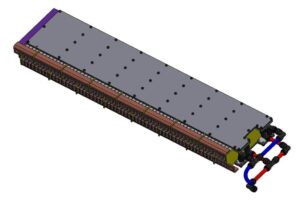Pie Aeronefs is a small firm in Switzerland, specializing in battery-powered aviation, and close to flying its single-seat air racer, the UR-1 Devil. We reported on this machine in 2021 at an early stage in its development, and now it’s going to be available as a kitplane. Adding to a bumper crop, their UG-2 Bullfinch will also be available as a kit.
Pronouncing that their aircraft are all zero-emissions machines, Swiss made, and innovative, Pie Aeronefs has this manifesto on its home page: “Pie Aeronefs is a Swiss all-electric aircraft manufacturer.
“Through distributed electric propulsion, our zero carbon emitting airplanes shall surpass the performance of conventionally powered competitors.
“Thanks to an innovative design, our aircraft are optimized for the electric energy system.”
UR-1 Devil
Supplied as a kit that the company says can be completed in 800 hours, the racer features carbon, aluminum, wood and electronics components, and “access to all technical data and assembly diagrams.” Customers have to supply glue and tools.
Probably not quite as self-assembling as in the video, the UR-1 aims for a top speed of 270 knots (310 mph) true indicated air speed (maximum speed in level flight at maximum continuous power.). Very light at a maximum takeoff mass (MTOM) of 400 kilograms (880 pounds), its battery mass of 120 kilograms can provide all-out velocity for a mere six minutes – just enough to cross a race finish line.
With an Emrax motor producing 150 kilowatts (201 horsepower), the 14 kilowatts of stored energy provide about six minutes of all-out power. Showing the effects of speed, the craft can cruise for 1.2 hours at a much lower power setting.
Electric components include the motor, which in the future may be one of Pie Aeronefs’ “future low profile aircraft motors.” It will be controlled by “The beating heart of our electric planes,” a Hyperion three-phase motor controller.
That beating heart controls up to 800 Volts of continuous current from the water-cooled Firebolt battery packs to the motor. Lightweight battery enclosures are made from a proprietary material able to withstand 1,000 degree flames for 15 minutes. According to Pie Aeronefs, “Electronic controls and internal fire stops virtually eliminate the risk of a ‘battery’ fire,” and each enclosure can contain a fully-developed battery fire while venting combustion gases.

Twelve liquid-cooled 10-kilogram battery packs in wings replace gasoline
Each of the 12 battery packs and enclosures weighs 10 kilograms (22 pounds) for a total of 120 kilograms or 264 pounds, a considerable portion of the loaded aircraft’s mass. Light weight, high power, and a sleek fuselage with a supine pilot all contribute to the expected performance.
UG-2 Bullfinch
Predicting performance on a par with conventional light aircraft, “Such as the Cessna 152 and Piper Warrior,[ the UG-2] is capable of completing all standard missions expected of light civil aviation at a fraction of the cost per flight hour. The $100 burger will cost $100 again!”

Pie Aeronefs UG-2 cavorting in the seacoast clouds, obviously far from its Swiss home
The Bullfinch has the same kit details as the UR-1, but with a 200-kilogram (440 pound) passenger allowance and 500 kilograms (1,100 pounds) of batteries. Its three-surface configuration is unique in this size and performance range. Most intriguing, the craft sports an “aspirated wing.” Pie Aeronefs explains, “Powering the little propellers on the wing of the UG-2, our general aviation prototype, a crucial part of what we call “aspirated wing.”

Fans and controllers inside UG-2 “aspirated wing.” Details will be forthcoming.
The Tesla-size battery pack enables four hours endurance and 500 miles of range with a reserve. One hour minimum recharging time would be just about right for that hamburger.
Your editor assumes the team will use the same motor and controller as the UR-1. Why waste all that good engineering?
UG-3 Peregrine
Looking even swoopier than its smaller stable-mates, the UG-3 is further in the future, with little detail provided by its maker. The maker says only, “As for now, we cannot communicate more than what you can deduce by looking at this image, but stay tuned.”

Pie Aeronefs’ UG-4 climbing toward the Matterhorn
Even further in the future, the UB-4 is going to be a more substantial business aircraft capable of exciting levels of speed. Earlier reports indicated it could exceed 600 mph over a 5,000 mile range, putting it in competition with the best out there. No public rendering exist at this point.
Combining Art, Science, and the Environment
Another recent offshoot of Pie Aeronefs , Swiss’ Carb, aims to share the experience and expertise of the firm’s resources. They will take on client’s projects and provide needed competencies in their execution. Interestingly and serendipitously, the August issue of Sport Aviation contains a Budd Davidson article, “Scrap Isn’t Junk,” about the value of leftover bits.

An example of Etienne Krähenbühl’s art. made with the assistance of and scrap composite materials from Pie Aeronefs
Part of their design is recycling scrap pieces of carbon fiber and other composite materials in new ways, including in art. Working with artist Etienne Krähenbühl, for instance, Pie’s materials are featured in his recent exhibition at the Château de Vullierens (Yverdon-les-Bains). His works celebrate the spirit of time and reexamine the concept of waste and how we can deal with it to respect nature.
In the air or the gallery, Pie Aeronefs’s small but talented team seems to have a flair for stretching the boundaries of flight and art.

